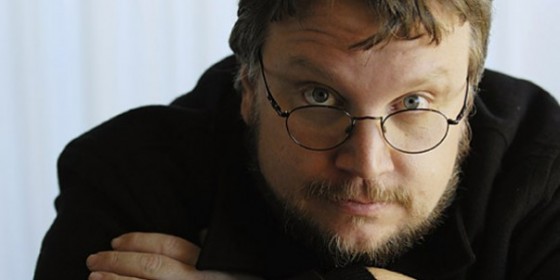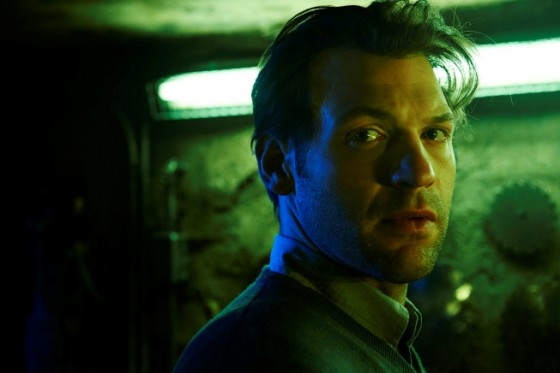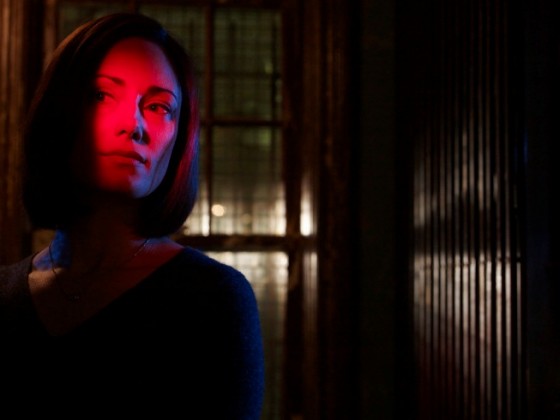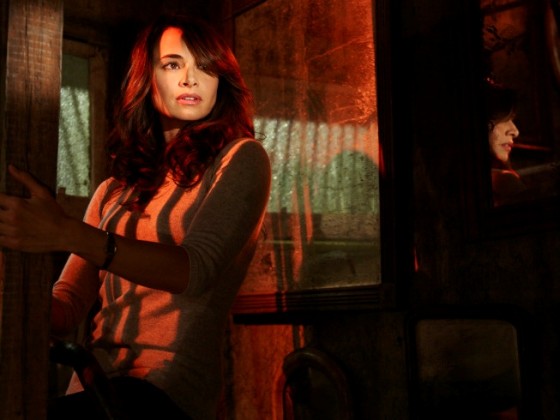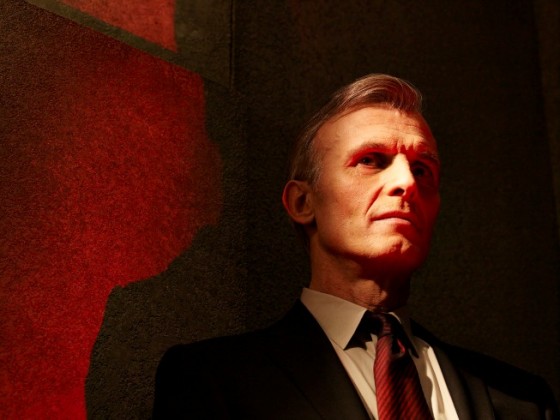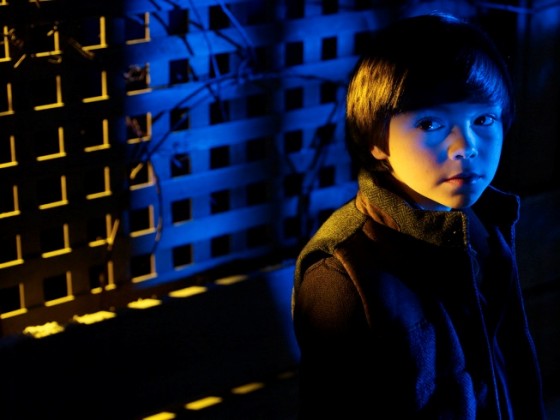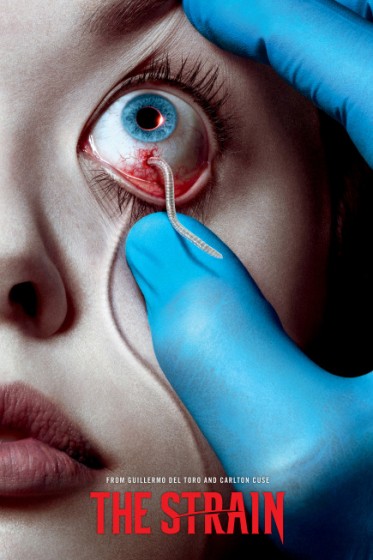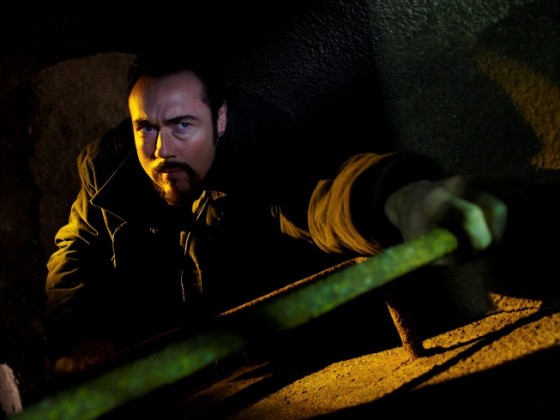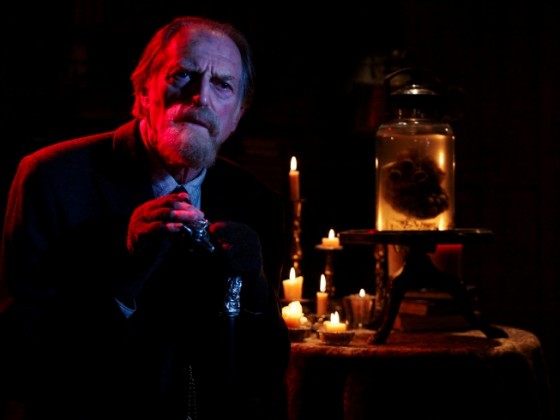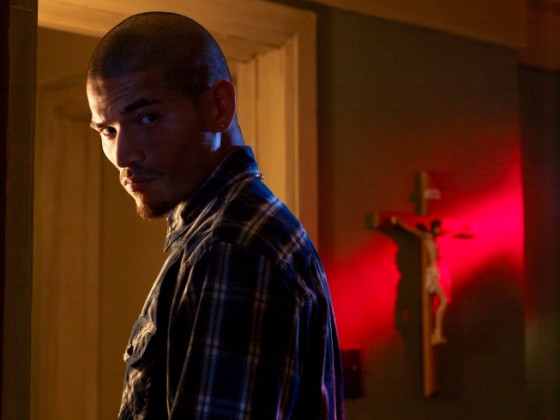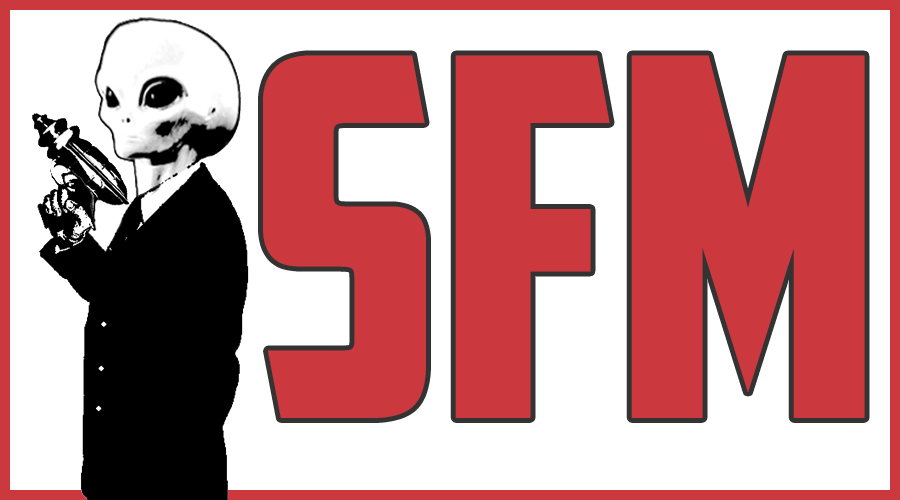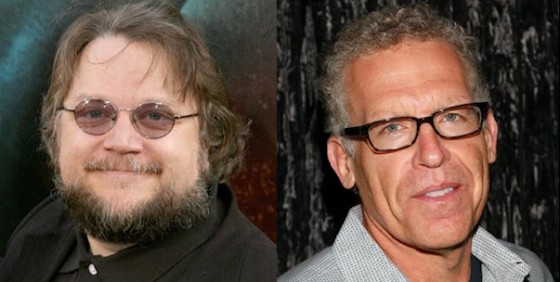
New series The Strain premieres this Sunday on FX, and is the first collaboration between film writer/director Guillermo del Toro (Pacific Rim, Pan’s Labyrinth) and TV writer/showrunner Carlton Cuse (Lost, Bates Motel). They each brought their considerable talents to the table, and the results are stunning.
To promote the series, FX distributed a press kit that included screeners of the first four episodes of the show a few weeks ago, then earlier this week offered a Q&A press conference call with Cuse and del Toro. SciFi Mafia has participated in dozens of these calls, and with major names like these, the call is usually limited to about 30 minutes.
Much to everyone’s surprise and delight, the two exceptional writers stayed on the line for 90 minutes, easily the longest press conference call I’d ever participated in, and the men were both wonderfully gracious, articulate, forthcoming, and fascinating. And yes, Losties, Carlton mentioned Lost more than once in this interview.
Because we had screened four episodes, some of the questions and answers are slightly spoilerish, but speaking as a spoilerphobe myself, it’s worth it to read what they say.
I’ve included the entire transcript here, other than introductions of each of the members of the press, as is standard with transcripts. Suffice to say, there were a large number of people on the call, representing a wide variety of media outlets. We were all limited to one question each, though some weaseled around that by asking multi-part questions. Ah well, I can’t blame them. Just know that almost every “Q.” represents a different person asking a question.
Even with limited questions and 90 minutes, however, not everyone was able to get a question in; FX reported that it was one of their biggest calls ever. I’m not surprised; the series is absolutely exceptional. You can see my review of the first episode here.
Unfortunately FX had a very strict policy that prohibits our reproduction of the audio, so you’ll simply have to imagine del Toro’s absolutely charming Mexican accent, and Cuse’s lovely bass voice, which you’ll be hearing weekly starting next week, when he intones “Previously on The Strain.”
Mr. del Toro wasn’t able to join the call until a few minutes in, so it began without him. Although I would have loved to have asked him a question, the fact that he wasn’t yet on meant that I felt comfortable in taking the opportunity to slip in a thanks-for-Lost comment to the beloved Mr. Cuse, since I was the first person put through to ask a question:
SciFiMafia.com Hi, thanks so much for taking the time to talk with us today. Lost changed my life, so thank you for that as well.
C. Cuse Oh, thank you.
SciFiMafia.com The first episode in particular is absolutely riveting and I loved it. Can you tell me how you first got involved in this and what drew you to it?
C. Cuse I had read the first Strain novel as a fan of both Guillermo’s work, and also independently I knew Chuck Hogan, and so I was very curious to see what this collaboration would look like. And I was just intrigued by the subject matter. I had read the first novel when it came out in 2009 and really enjoyed it, and then basically about two years ago my agent called me up and said that there was some interest in doing The Strain as a television series and would I be interested in it.
And I went and met with Guillermo and I had a really good meeting, and I basically decided to get involved, for two reasons. One, because I had a lot of respect for Guillermo as a filmmaker and I thought, particularly in a monster show like this, that he’s one of the most imaginative guys out there in terms of creating creatures and worlds. And I also thought that embedded in the book was this fantastic opportunity to upend the vampire genre, as the vampire genre has sort of been overrun by romance, and that we had had our fill of vampires that we’re feeling sorry for because they had romantic problems. And it was time to go back to the conception of vampires as really scary, dangerous creatures, and in so doing that there was a way to kind of make a genre show that would be different than anything that was out there on the TV landscape.
SciFiMafia.com Excellent, thank you so much.
C. Cuse Thank you.
Q. I have to say The Strain, I am incredibly impressed with it. I find it just is riveting. Now being on cable, though, having done network shows before, has this really opened up what you can do with a series for you as a producer?
C. Cuse Oh, absolutely. Look, I can’t speak broadly to all cable channels, but I will say that FX has been fantastic. And I will say that this show really represents my and Guillermo’s version of the story. It’s really unadulterated. I mean, yes, sure, we can’t drop F-bombs, but that’s about it. We really were able to put our unadulterated version of the story on screen, and FX has been enormously supportive, and I think very aware when you’re competing with films and also with pay cable, you don’t want to find yourself in a situation where you’re doing an adulterated version of the story. And that was something that we were very conscious of and concerned about, and John Landgraf and his team were immensely supportive and really gave us the latitude to tell the story the way we wanted to. And so it’s got some pretty extreme moments, but I think that that also is kind of what gives the show its octane.
G. del Toro Speaking of FX team, I’m here.
C. Cuse Hey, man. Yes, so I think that we really felt like we were able to make the version of the show that we wanted to make.
Q. Well, it’s incredible, believe me. You guys have done a wonderful, fantastic job, and keep doing it.
C. Cuse Thank you.
G. del Toro Thank you.
Q. Hi, guys. Thanks so much for doing the call. I have to say, the screeners were awesome. I started watching at around 3:00 in the morning and planned to watch one, and I ended up really late watching all of them that they sent, so I really love it.
G. del Toro Thank you.
Q. I have not read the book yet, I’m planning to, but I’m curious, how closely is the mythology going to follow that? And also, do you have it spaced, like is season one going to be book one, how are you planning to figure that out?
C. Cuse Book one is season one, yes. We basically follow the narrative of the first book in the first season. The plan is that the show will run somewhere between three and five seasons, and as we work out the mythology and the storytelling for season two we’ll have a better idea of exactly how long our journey is going to be. But it won’t be more than five seasons, we’re definitely writing to an endpoint, and we’re following the path as established in Guillermo and Chuck’s novels. But obviously there’s a lot that’s also going to be added. The television show is its own experience, and there are new characters and new situations, different dramatic developments, so the show and the book can each be separately enjoyed.
And I think that the goal is not to literally translate the book into a television show. You want to take the book as a source of inspiration and then make the best possible television show that you can make. And I think Guillermo, Chuck, myself, all of us involved have basically said, okay, here’s the book, now how do we take the best stuff in here and then use that as elements and then make the best TV show we can. But we view the TV show as its own creation.
G. del Toro And it was very clear from the start that we had the three books to plunder, but we also had the chance of inventing. We talked about milestones, that we want the milestones and the characters that are in the book to be hit, but with that it became very malleable. Carlton decided, I think very wisely in retrospect, it made perfect sense as a game plan to, for example, leave the origins of The Master, which we opened book one with for a second season, if we go that way, and, for example, bringing a set piece from book two to bookend the story of one character on season one. So, it’s a very elastic relationship that the series has with the book, but by that same token it’s very respectful and mindful of the things that will not alienate someone that likes the books. It should feel as seamless. And I think the decisions we have to understand when Carlton is guiding us through this new medium for the story, to trust and know that his decisions are guided by huge experience and a prestigious career.
Q. Thank you so much. I’m a huge fan of both of yours, so thank you.
G. del Toro Thank you.
Q. Hi, there. Thanks for the call. It always strikes me how popular police procedurals, and murder, and gore, and blood, and pain, and death are in our culture. We seem to appreciate that kind of genre so much, and I wonder what it is about us that we do?
G. del Toro From my end what I think is very apparent is that we’ve come to the point where socially, as we are mammalian creatures we are territorial, we are built to fight and fend off territorial challenges, reproduce, and sit a sedentary life, you know, ultimately that’s the way we’re socially and animalistically geared, and yet we live in a society that the more it isolates itself from its natural instincts, the more it seeks them in entertainment. And I think there is a vicarious thrill your brain needs, the way your body needs the exercise in a way, your brain needs to be exposed to flight and fight instincts, and you seek it through a roller coaster, or some people seek it through extreme sports, or you can seek it in genres like noir crime, horror, adventure, etc. It’s literally a biochemical mammalian biofeedback with how we are constructed to organize the storytelling in our lives, I think.
C. Cuse I completely agree with everything that Guillermo said, although I don’t discount that some reptiles will also like the show.
Q. Hi, guys. This is a question for both of you. Guillermo, starting off with you, how was the transition from feature films to cable television, and what did the two of you learn working together on this as you made the tremendous trilogy turn into a series?
G. del Toro The transition came from both Chuck and I, it was very smooth in many ways because we had the chance to adapt the novels to comic book form with Dark Horse. And coming in we really sought Carlton’s guidance into this new form. I think there never has been an occasion in which our dialogue has seen anyone read the books and say, “This is not the way it’s in the books.” So that much was very satisfactory. For me as a producer and director, it was about having some of the quirks that come from a feature film. I asked FX to give us a long pre-production period so I could really plan out the makeup effects, the creature effects, the visual effects, all of which I have big experience with, in order to try to bring to the pilot a big scope feel to the series doing sophisticated effects and some set pieces, while staying on a fiscally responsible budget and managing.
And from a director’s point of view it was the same on the pilot. I didn’t want to go back and say, can I get one day more? Can I do many extra hours? I wanted to fit in the sandbox what I was hoping would feel like a big pilot episode for a big series. And that pre-planning was crucial, but also adjusting the way I staged, the way I approach coverage, or storytelling, and yet not sacrificing anything. It was both some fiscal constraints, but creative absolute freedom, which was a huge thrill for me to get a phone call from John Landgraf before starting the series, saying to me, “We encourage creator content, we love Carlton, we love you, and we want you guys to do the most idiosyncratic, best version of the series that you can.”
C. Cuse And for me I really jumped at the chance to work with Guillermo. I had not done a show with creatures, and so to be able to do a show with creatures with, in my opinion, the best creative of creatures out there in the world was an incredible opportunity. So it’s been a great learning experience for me really to collaborate with Guillermo, and I think the show has been a really great combination of both our processes, in that we have a very complementary set of skills.
And I will echo what Guillermo said, we approached the making of a television show with a lot of the things that you do when you make a feature, and I think that there are inherent limitations in television if you think about the network model, where a series might get greenlit and then you would literally be in production six weeks later. It would have been impossible to make this show under a normal network production schedule. We needed a vast amount of lead time to not only do creature creation, but to do a significant amount of the writing so that we could plan and organize things, because obviously we were working within certain fiscal limitations, but by having all this planning time I think we were able to bring something to television that you just wouldn’t be able to do under normal circumstances. And so we’re incredibly grateful to FX for being so supportive in allowing us our process.
Q. Hi, gentlemen. Thanks for your time today. I know you were talking there a lot about having complete freedom to do the show the way you want. So, are you saying that you haven’t walked up to and crossed that line yet as far as things you can and can’t do? There hasn’t been a “no” from the network yet saying, “You know what, the tendril coming out of the young girl’s mouth can only stick into her dad for 7 seconds, not 10.”
G. del Toro Obviously not yet.
C. Cuse No. Honestly, I think that whatever aesthetic limitations exist in the show are ones that Guillermo and I came up with ourselves. We have had the full support of FX to make the show the way we wanted to.
G. del Toro And I think that one of the important things on creating this is that the genre requires you to cross, at some point. It’s almost like a hostage situation, where you need to show an audience that you’re not kidding, you know? You have to show you are going to deliver either by atmospheric, creepy moments, or by visceral punch, hopefully both. You’re going to be able to deliver the goods, the things that will make you feel queasy, will make you feel unsafe, will bring this delightful shiver that is required with the genre.
And you can execute it both atmospherically and by simply making the emotional relationship of a father welcoming a daughter long after he knows she’s dead, or by making it a shock moment. Or, hopefully also now and then in the series we have moments in which we have really, really sick humor. Certainly in the pilot we had the freedom to try to set up one of the most intense scenes to a pop song, and things like that I think are what defines a generic appeal for the show.
Q. Well, a job well done. That tub scene had me looking through my fingers. Thanks, again.
G. del Toro Thank you.
Q. Hi, guys, thanks for taking the time out. We’re starting to see this big proliferation of genre stuff, which is obviously not new, but the comic book stuff really has been invading TV. Just on broadcast alone there’s five new shows based on comics. What do you think is behind that proliferation, and Carlton, you tried this before with The Sixth Gun, what goes wrong, and what do you think could be next?
G. del Toro Go ahead, Carlton.
C. Cuse I think as a creative person, as a show runner I don’t really think about the larger trends. I think about what I connect to emotionally. And so for me I connected to this story, I felt there was a way to upend the vampire genre here. I felt like there was, as I said before, for me kind of a wonderful collaboration to be had, as well as the bones in this story, of a way to, I think, to tell a great monster story for television that would find its own unique footing in the television landscape. I really think our show is different than anything else that’s out there.
And I would add to what Guillermo said before, I think there are these delightful moments, shocking moments, but I think there’s a lot more to the show also. I consider it to be a thriller with horror elements, but there also are, I think there’s an incredible mosaic of characters engaged in all sorts of interesting, dramatic conflicts, and I believe that the show will appeal to a broader range of people. It’s not a show just for horror aficionados. So, I think while it is a genre show, I think we’ve made a genre show that I think is more than just being a straight genre show.
G. del Toro And to answer your question, I think that the way we have, and when you talk about the baby boomer generation, or a second generation of film makers raised in Hollywood, every generation brings with them the media in which they were raised as part of the narrative leap in what is acceptable or not in mainstream entertainment.
In the case of the generation presently dominating the landscape, you have a huge acceptance of pop elements in culture. The viability of comic books, video games, or other forms of entertainment is not something new, but it’s pervasive right now because it came with a generation that have a pervasive influence of those mediums in the way they shape their narrative about their fiction. But everybody knows the first Batman was a black-and-white Batman right at the time that the comic book strip was in vogue. Flash Gordon. It’s always the interaction of genre and media in mainstream movie making, and media that is alternative to that has always existed.
I think that the only thing I feel has changed lately is very often myself as a comic book collector and reader, find out that many comic books feel almost like a trial for a movie or a TV series. And I gravitate more towards comic books that remain idiosyncratic and strange.
Q. Thank you so much.
C. Cuse Thanks.
Q. I want to congratulate you, I think you really delivered the goods. And so I’m wondering about when you say five seasons over and out, any thought that maybe would extend beyond that if the public response is great?
C. Cuse I don’t think so. I think that we’re moving into this new phase of television where I think audiences are really embracing stories with a beginning, middle, and end. And if you look at the success this season, for instance, of True Detective and Fargo, as well as the kind of incredible response that the end of Breaking Bad got, I think that you have to recognize that the audience wants to see stories that come to a conclusion. They want the full and rounded experience. And television has been sort of a first act and sort of an endless second act, and I think that the best television now is giving you a three act experience. And I think that that’s what we want to do with our show.
G. del Toro I agree with Carlton. I think one of the things that we made essential when we pitched the series everywhere, and certainly at FX, is we came in and we said we are not going to be extending beyond the—we presented two arcs, one that can fulfill three or four seasons, and hopefully the second or third book are complex enough that they can generate a fifth one. But we literally said it needs to end when it needs to end, and that was a central part of finding a home for the series.
Q. It’s a great show.
G. del Toro Thank you very, very much.
C. Cuse Yes, thank you.
Q. Thank you for talking with us today. When I was watching the screeners I was curious, and I think you touched on this a little bit in the previous answer, but I was curious why you decided to do a full blown series versus doing a TV miniseries, that’s become really popular, perhaps a TV movie, or even releasing it all at once like a lot of the streaming series are doing?
C. Cuse FX’s model, our partner in the show, is not a streaming service, so that sort of eliminated that.
Q. Is that something you had to consider during the creative process?
C. Cuse No. Look, I think for us, I’ll let Guillermo speak as well, but I think certainly for me the material, I think you basically choose the medium that most fits the material, and I think the three books are an incredible source material. And I think they lend themselves to a series more than a miniseries, more than a movie, and it felt like a very natural and appropriate match to look at the books as a three to five year television series experience.
G. del Toro When we started writing the books the story of it is a little convoluted, because it was originally pegged as an arc for a series. And I knew from the get-go that it was three books when I approached Chuck with the bible I had written for it, and I really wanted something that we accomplished in the books, which is the books feel very different one from another. It is my dearest hope that we can bring that evolution to, God willing, further seasons of the show.
One of the things that linked me very strongly to Carlton is when we met, we met one fateful morning for breakfast, and he said to me, “I love the fact that you start the first book debunking the spiritual aspect and the mythical aspect of vampirism, and the second book you go into sociological aspects of the tale, chemical, biological aspects of the tale, and you come full circle on the third book recuperating a new spiritual dimension to the myth.” And we knew that journey was not achievable in a single swift six episode arc, or eight episode arc of a miniseries. We knew that structurally we wanted each season to not only continue what you did on the first one, but to evolve into different and hopefully more increasingly daring territory, and I think that in that sense it really was the natural way to go creatively.
Q. Excellent. Thank you, guys.
G. del Toro Thank you.
C. Cuse Thank you.
Q. Good morning, gentlemen. Thank you for taking the time for us.
G. del Toro My pleasure.
Q. Guillermo, specifically for you, after directing the pilot, do you think there’s a chance that you’ll be back to direct any more episodes in the future?
G. del Toro It is with both great pleasure and great trepidation that I say I want to direct the opening one if there is a second season. And I say trepidation because obviously it is always almost like doing cardio, directing TV is like doing cardio, and if you look at me in any picture you know I don’t do cardio. But I think that the beauty of the show is we have developed a really good, increasingly fluid relationship, Carlton, Chuck, myself, and I think now and then in the first season I would go and shoot additional material with a Saturday second unit, or Carlton and I could increasingly jab each other into coming up with sick ideas in the middle of the season.
And I think that I really would like that, because it is such a pleasurable experience. You come in, it is incredibly intense on a day to day basis, because each day on a TV series it seems like a week on a feature, but I do hope that. As it is, I have made it a point to stay obsessively involved in supervising every single of the effects in the series, supervising makeup effects, color correction, this and that, and I feel this is our baby, neither just Chuck or Carlton’s or myself, is the three of us. It’s like Three Men and a Baby for vampires, and I think that it will be essential for me to continue to be involved in that way.
Q. Thank you.
Q. Hi, guys. I’m a big fan of both of yours. Thanks for talking to me.
G. del Toro Thank you.
C. Cuse Thanks.
Q. My question is, how did you choose your writing staff for this show considering the elements involved with the genre, the sprawling worlds, the source book, etc.? How did you find your staff?
C. Cuse The job of putting together a writing staff is always something that I think of as akin to assembling an orchestra. You need to find people who have different voices but who all can harmonize together and create a single sound. So, first and foremost, I was very happy that Chuck Hogan wanted to engage not just as the co-writer of the books but also as a writer on the show.
And so having Chuck on staff has been a hugely wonderful thing. I hired these two wonderful writers from Battlestar Galactica, David Weddle and Brad Thompson, and then I hired Regina Corrado, who was on Deadwood and Sons of Anarchy, and Jennifer Hutchinson, who was on Breaking Bad, and a wonderful young writer named Jason Brigg Gibson. And we had this wonderful combination of different voices and writers with different interests, all of whom I think brought something really unique to the very complicated and arduous process of adapting a book into a brand new creation as a show. And there’s lots of new stuff in the show, there are new characters in the show, there are lots of new situations, and each of these writers really contributed to that process.
G. del Toro I think that in this I completely rely on Carlton. When the charge of a show runner is applied, you know who’s running the show, and Carlton has the experience and the knowledge and the capacity to cast the writers’ room in the way that he thinks is appropriate for the show. And we jibe, we veto ideas and so forth, but ultimately he’s the arbiter of how that part of the show goes and the direction the show takes, and who gets to participate as a writer. I think we have a great sampler of different disciplines and different points of view into the story that he needs to orchestrate into something seamless.
Q. Great, thank you.
Q. Hey, guys. How are you doing today? I wanted to ask you about Lance Henriksen’s participation in this, because I think it’s very creative. I want to hear, just from Guillermo, how did you woo Lance? You are obviously a friend of his, but can you talk a little bit about Lance and as well as the creature design, because this isn’t the first time you’ve tread down the vampire path, Guillermo.
G. del Toro Yes, the thing that we know is that The Master, the character, encompasses many voices, so he’s a character made of many voices over the centuries. He overtakes bodies and he stays alive that way. So we wanted to meld several voices, and one of the voices that we wanted to use was Lance, because of its power and authority and the way it sounds, and then mix it with other voices as the base for The Master’s voice, for the authority and the power it has.
And in terms of creature creation we really went into it trying to, little by little, reveal the biological traits and the design traits of these creatures to make sense to an audience, not just from a looking terrifying, looking good point of view, but to make them feel organic, to make them feel like almost a different breed in the evolutionary history of this planet. You get to see them as a species, in a way, the more you advance in the plot and in this series. So, designing it took approximately six months of just purely conceptual and sculpture and draftsmanship design, and executing it took a very long, long time. But it was as complex and as demanding as designing creatures for a feature film.
Q. Very cool.
Q. Good morning, gentlemen. Thanks for taking some time for us today.
G. del Toro Yes, thank you.
C. Cuse Thanks.
Q. I have a stylistic question for you guys. We’ve seen a lot of movies and television shows where they deal with an outbreak or a contagion and they usually have this very bleak, very gloomy, washed out color palette. The Strain goes in the completely opposite direction; everything is very saturated, it’s very rich, the colors are very vivid. Was this a conscious choice to make the show stand out a little bit more?
G. del Toro One of the reasons we asked FX for a long lead time for the show was that I spent a long time working out line and saturation patterns with coordinating art department, wardrobe department, set design, and cinematography to give the show a very strong look. I was jokingly calling it “saturated monochrome,” because we have very few colors in the show. We are going for a palette that limits itself to basically cyan and amber in clash with each other, and then they make room for red to exist. And red is only in connection with the vampires.
And the other thing that I wanted for the show was that if you’re channel surfing – the show would almost pop out and demand your attention visually. I wanted it to have a very strong inception from comic book form and illustration. But when people think about it they need to think about it as an orchestration of wardrobe, set, cinematography, and ultimately the way you texture the clothing, the walls, the sets, and to giving it a unique look. And I went for this color palette because the clash in the show, you’re talking about daylight and nighttime, so it’s a clash between gold and blue basically, night and day, and that led me to cyan, which is a color in the spectrum between blue and green, so to speak, and that is the night world, and then the amber, which is the day world, clashing.
And in between those colors, every time you see red, with the exception of a police siren or a fire extinguisher, something causally of the real world, every time you see red – you know it’s linked in some way to the vampires. So, some of the characters that are going to turn in the pilot are coded, even from the beginning, to have a little bit of red, sort of creatively telegraphing to, at least me, or anyone in retrospect, that they were linked to that world.
Q. It looks amazing. I love the show, so congratulations to you guys.
G. del Toro Thank you.
C. Cuse One of the things that we talked a lot about was trying to make the show look, sound, and feel different than other shows on TV. It was one of the things that I think we achieved pretty well with Lost. When you flipped around on the channel and you heard Michael Giacchino’s music and you saw the lush, verdant Technicolor jungle you knew where you were and that it was a different destination than other places on television. I think Guillermo’s, again, I think deeply imaginative and is a visual creator, and we have a show that I think really looks unlike anything else on TV.
Q. I would agree with that.
Q. It’s a pleasure to be speaking with you guys. I’ve been excited about this show since I found out about it, so congratulations.
G. del Toro Thank you very much.
Q. My question is about the creature development which you referred to. I was so stunned when I saw your first creature, just by chance on Google, and have been fascinated with the development of the idea of these kinds of creatures, with the powers they have and the tongues that they have, and their appearance and stuff like that. Can you give me some idea of how the concept of these characters developed in your mind?
G. del Toro Yes. I’ve been obsessed by vampires for a long, long time, since I was a very young kid, and a very strange kid. I read about vampire mythology worldwide and I familiarized myself with the Japanese, Filipino, Malaysian, and Eastern European variations on the vampire, and many, many others. And I kept very detailed notes as a kid on where to go with the vampire myth in terms of brutality, social structure, biology, this and that, and some of those notes made it into my first feature, Cronos, some of them made it in Blade II, when I directed that, and most of them made it into The Strain. And designing them, we knew and we had it very clear that, for example, The Master needed to be hidden for at least half the season or more to not make him that accessible.
And I came up with the idea that this guy that has been alive for centuries and essentially is an apex of the Dark Ages in the middle of a world of imminent modernity. You have people with cell phones, jet airplanes, iPads, texting, Internet, all of that, and in the middle of it there is a 9 foot tall, hand carved coffin with a creature that has been alive for centuries. And it’s ancient, and that’s what makes it powerful, that it doesn’t care about any of the modern accoutrements of mankind that gives mankind such a false sense of security.
And The Master needed to look that ancient, so we decided that he was going to become his wardrobe and that eventually when he reveals himself you have a second layer. So we designed the wardrobe, the cape and the multiple layers of clothes that are falling apart, because he has an accumulation of clothes over the 1800s, 1900s, 21st century, he’s just accumulating rags, and he needed to look like a lump, like a bunch of rags thrown on the floor, then come alive, and out of all these rags comes out this incredibly glistening and viscerally biological appendage that then drains the first victim. And that’s the way we started guiding the process of designing The Master. And the more we go into the season, the more you see of him and the more you discover layer after layer of that creature design.
Q. And what about the other characters?
G. del Toro Well, I knew that the older the vampires stay alive, the older that they stay alive, the more they lose their humanity. They start literally by losing their heart. Their heart is suffocated by a vampire heart that overtakes the functions. And this was important metaphorically for me because the beacon that guides these vampires to their victims is love. Love is what makes them seek their victims. They go to the people they love the most. So they turn their instinct that is most innately human into the most inhuman feeding mechanism, so their heart is dead.
Then shortly thereafter their digestive system is overtaken. Then, as we do in an early episode, their genitals fall off. And their excretion system becomes really, really efficient in the way that ticks, or lower forms of life that feed on blood do, a tick in order to feed needs to eliquate itself, and they are eliquating while they are feeding. And in the series that comes with the big splashes of ammonia infused liquid that they expel while they’re feeding. And then I know that they lose their soft tissue, their ears start falling off, their nose, if they’ve been alive for several years their nose rots and falls away, and they develop a tracheal opening to vent the extra heat from the metabolism and to project the stinger. So, I take a very biological approach. It’s not just, oh, that looks cool. I try to have it make sense biologically in the design.
Q. Well, that is quite astounding. And thank you for sharing it with me.
G. del Toro Thank you. And you notice they lose their hair because their body heat is so big it consumes the fat in the scalp, burns the roots, and they then change color because they lose their red cells. One of the things Carlton and I have the most fun in writing the novels is Carlton would call me any time he needed a biological angle or an explanation. And we would talk about it for a while, because I really love and know these vampires well.
Q. Well, that’s just amazing. Thank you so much for sharing.
G. del Toro Thank you.
G. del Toro Hello.
C. Cuse Hi.
Q. I just wanted to ask you quickly about the billboards that ran in a couple of markets, certainly here in LA, and maybe in New York as well, with the eyeball worm. That’s absolutely wigged some people out.
G. del Toro Yes.
Q. I was wondering what you thought about that. Did you expect such a reaction? Does that maybe set you up for what people might think of the show? They might be just completely twitchy and wigged out by it. Did you agree with the decision to swap out some of those billboards?
G. del Toro Carlton?
C. Cuse I think that the advertising was bold and imaginative, and clearly not for everyone. And I think that FX does a credible job marketing their shows and I think they wanted to convey that the show was edgy and bold, and out there. And I certainly understand that it might have been too far out there for some people, but I personally liked it. But I understand that it was necessary for them to make some accommodations if some people didn’t like it.
G. del Toro I feel the same way. I trust FX. I think they have a really great sense of, A) who their audience is; B) what their type of advertisement is, and they’ve generated some pretty extreme and chilling images in the past. Carlton says it’s not for everyone, and I think that as much as I think the show has many, many layers of appeal, in my opinion, and certainly the more we go into the season the more we go into developing these things we do go to territories that are pretty extreme and graphic, in the first scene we’re talking about a biological takeover and a viral takeover and a body invasion series, and we go into places that are extreme. And they are extreme because we’re dealing with a fear that is, I think, essential, which is a biological invasion. It’s not a knife slicing someone open. Literally when you come to think about it, it is the concept that is disturbing, the worm with the eye, the juxtaposition of those two things is very powerful. And it is representative at least to the most piqued sort of invasive horror that we do explore in the show.
Q. Hi, guys. Thanks for your time.
G. del Toro Thank you.
Q. I wanted to ask you about revisiting the books as you were making this series, whether or not there were elements within the book that you wanted to preserve for the book experience and keep that a unique experience, when mining things for the TV show was there some kind of discussion between you guys as far as what to translate and then what to preserve of the book?
C. Cuse No, I don’t think so. Well, there was a lot of conversation about what to translate. We never discussed preserving something for the books. The experience of reading a book is always unique. I believe that you render a version of the story when you read a book in a way that is unique and special to each person who reads it. And I think the experience of reading those books is going to be always separate from what the show’s going to be like. I think we basically, my approach with the series was let’s take the best of what was in the books and let’s figure out how we can translate that into the scripted form and make that into the best version of a TV series. And in many cases it was also, okay, here’s an idea that’s in this book that’s really great, how do we actually embellish this, how do we take this and make this into even more of a story?
So, the books were, and remain, an incredible source of departure and inspiration. But again, it’s a very artistic process to translate and adapt a book into a series, and I think we really felt very early on that the two just had to be their own thing. And we would use the books as far as we could and then we would add stuff as it made sense, and that’s what we did.
G. del Toro As far as myself, obviously we have to choose what stories and what quirks you tell and not tell from the book. There are, believe it or not, far more disturbing moments in the book, here and there, than there are in the series, because some of them are very powerful when you read about them, but they are almost unbearable if you were going to stage them the way they are described in the book. So, believe it or not we did exercise restraint.
And the other one is that we have in the three books at least one or two instances of an epistolary device, being a diary, or a letter, or a document being part of the narrative. And we threw that away to have a right here, right now type of narrative that I think lends itself much better to the TV series.
Q. Hi, thank you so much for taking the call today.
C. Cuse Thank you.
G. del Toro Thank you.
Q. I watched the first four episodes, and this all with a compliment, it is disgustingly fantastic.
G. del Toro Thank you.
Q. I absolutely am just waiting for the next episodes to come on. How involved were both of you in casting, because the production value in just even the first episode is beyond anything that I’ve ever seen on TV and it’s just wonderful. But the cast is fantastic, how involved were you in casting?
C. Cuse Guillermo and I cast the entire show together over almost a year. And again, it was another one of those advantages of having a lot of time to prep the show. We had a lot of time to thoughtfully consider who was going to be in our cast. Also we have to give a lot of credit to the wonderful April Webster, our casting director, she cast Lost, and she came and did our show. And she has wonderful taste and a wonderful ability to find actors.
We met a lot of actors and we spent a lot of time discussing and considering who would be right for these roles, and as I said, we did it thoughtfully over a long period of time. And it’s just a hugely important part of the process. The longer I’ve done television—I used to have a lot more hubris about the power of writing, you know that it would conquer all, but I don’t anymore. I really think that as good a job as you do as a writer, you’re absolutely indebted to the actors that have to deliver that material. And we were incredibly fortunate to get some wonderful name actors like Corey Stoll, but to also find some amazing discoveries like Miguel Gomez and Richard Sammel.
G. del Toro Yes. I think that we have a great collaboration with April, and we cast everything together. Literally we had sessions of casting in the same office, and in the case of at least two or three of the parts we basically didn’t cast a wide net, we knew who we wanted, and when meeting the actors proceeded to offer them the role right there on the first meeting. And it happened again and again. We saw the casting as a mixture of going for the unexpected. Or, like in the case of Sean Astin, we said I think his character and the turn of his character is really feeding on his persona and his baggage in a great way, he’s so reliable, so adorable, and his character has to do things that are ambivalent. In the case of Corey, and almost more cases than I have ever seen in a project, we were completely in sync in the casting.
Q. Hi. Thank you both so much for taking our questions today. I was wondering about the David Bradley character in particular. Will he become more involved in the narrative as time goes on? Will he become more involved with Corey Stoll and his arc, or will he be doing his own thing for most of the season?
C. Cuse Oh, no, no. Part of the fun of the way that the storytelling is structured is that this mosaic of characters that we’re following, I certainly hope the audience will enjoy as much as we do this idea of waiting for when they’re going to cross and how they’re going to cross and how they’re going to connect to each other. And we spent a lot of time figuring out in the writers’ room at what point we were going to have these characters intersect and how they’re going to intersect. So, yes, David Bradley is a huge part of the show, he’s a wonderful actor. And I think Guillermo and I, we wanted a guy who wasn’t going to be the sort of sweet, kindly, grandfather, sort of kindly mentor figure that we’ve seen in a lot of shows. We wanted Setrakian to be a bad ass, and David Bradley was the perfect piece of casting, and he plays a hugely significant role in the series.
G. del Toro It was clear from the start that we didn’t want the wise, gentle father figure mentor. We wanted a guy that had a lot of edges and that became a bristling sort of hub for all the characters. And I think literally every character ends up circulating around the figure of Setrakian, even Corey and Mia, they connect with the rest of the characters through Setrakian. And what we did that I enjoy a lot is that we have false crossings of characters, like characters meet briefly and they don’t have to come together yet. That is the case clearly with Miguel’s character, Gus, who meets two of our main characters and yet he doesn’t become one of the gang right away. And I think that’s really nice.
But Setrakian is, in many, many ways the one element of the show that goes through the mythology of the ancient and the modern but brings a very, very hard edge to the figure of the man who knows. He’s not whimsical, wise. He’s impulsive, he’s aggressive, he’s really, really edgy, and capable of big, great sweeping actions. And casting David, who is the most vital guy, I think, and no one would get offended if I say he’s the only member of the cast that unfailingly skis in his free time, or dances salsa at the drop of a hat, I mean this guy, regardless of his chronological age, has incredible vitality, and that feeds into the role.
Q. Hey, y’all. How are you?
G. del Toro Very good, thank you.
Q. Good. You guys have talked a lot about the network of FX and stuff, and I wanted to ask you, because a lot of fans of FX like of The Americans, American Horror Story, and Sons of Anarchy, have some pretty specific expectations about a show that they’re going to watch on FX. And I was wondering if you felt any kind of pressure to conform to those expectations, or to perform to them, or how are you dealing? Because they already have sort of a set expectation of a show they’re going to see on this network.
C. Cuse Well, I don’t know if I agree with the premise. I think that if by specific expectations you mean they expect it to be good, then I do agree with you. I think FX has become really a purveyor of quality drama, so in that sense I think the bar at FX is high. But I think that as a creator all you can do is make the best version of the show that you know how, and this show is kind of a combination of Guillermo and my aesthetics, and I think we set out to make the show that we would want to see, in our guts we were like “this is the show that we like, that we care about.”
And I think that in some sense that the decision of whether it fit for FX was made when FX bought it. I think John Landgraf made that decision by deciding that he wanted to buy this property. There was a very clear road map. Not only that, John Landgraf read all three books before he decided that he was going to be our partner in this endeavor, and so he knew exactly what he was getting, and so he’s the one who I think made the decision that, yes, The Strain as a story fits into the portfolio of shows that are on FX. And then it was really up to Guillermo and me to deliver our best version of that show for those guys.
G. del Toro I understand what you mean. I think that the FX brand, of which I am a consumer, I love it, as evidenced by the way I cast my movies, be it with Charlie Hunnam, or Charlie Day, or appearing as a guest actor in Sunny in Philadelphia, I know the brand.
And I think that what we got from our meetings with John Landgraf, as I said, is that he said, “look, we are very, very creator content driven,” and I know that you need to have an edge to belong in the FX brand. But I think that at the same time we are bringing viscerally and in terms of scope new stuff to the brand, helping it define what the breadth of what they do is. And we wanted to bring big production value and a sense of visceral aesthetics that feels manicured and very actively designed. As opposed to more reality based and viscerally of this world, we needed very extreme aesthetics in order to fit a storyline and characters and things that you cannot safely just toss into the real world and expect them to stick. So, I think that we do belong, in a beautiful way, in content that is creator driven, or encouraging the creation of individual voices in the sense that we keep a very manicured and carefully designed look, but we go to very edgy places with the content.
Q. Hi, thanks for taking my call. Obviously today pop culture is really inundated with lots of vampire stories, I think Carlton said that earlier, so my question to each of you is, what makes The Strain special for you?
G. del Toro Carlton?
C. Cuse I think The Strain upends the current conception of the vampire genre. As I said before, I think we’ve had our fill of romantic, brooding, sparkling, depressed vampire characters, which those are really sort of like love stories sprinkled with a genre. The idea of sort of re-imagining the vampires, going back in a way that the roots of what vampires are, that they are scary, dangerous creatures, that was something that was incredibly compelling for me. That was something that really drew me to the project, and the idea that when you see these things it’s not good.
So, on one level, and I also love all the stuff that Guillermo said before about the biology and stuff, that it was also thought through, again, I think Guillermo’s just a master of creature creation, and so that the prospects of working with creatures that were unique and so complicated and so cleverly imagined was an enormous appeal, and that conception of them was really vastly different than what we see in other shows. And that completely appealed to me.
And then I would just add one other layer, which is that on a show like The Walking Dead they have zombies, and those zombies are capable of doing a few limited things. I think one of the things that’s really interesting about this story, that really inspired me as a show runner and storyteller, is the layers of mythology. And as the show goes on we not only learn about the functioning of these vampires, but we also come to understand that there’s a hierarchy of vampires, and then there’s a history to these vampires, and there’s a mythology behind the existence of these vampires. And as that unfolds and as we began to understand that these creatures are not only scary and dangerous but also sentient and smart, that adds just a whole other layer to the forces of antagonism, which just makes for great storytelling.
G. del Toro Yes, I think that obviously this is a mythology I’ve been living with for many, many years. And I think that if I have to find vampires similar to what we are doing, the only other relation I can find is my own creation in Blade II, which comes from the same set of concepts, albeit a much more limited number of ideas we’re able to go into to fit that universe. But very rarely do we get to see a savage form of vampirism in either film or TV, or basically any other medium, so I think the degree to which this mythology and biology, and basically lore of this type of vampire, is laid out is really quite unique and evolving.
And I think that, God willing, we have the chance to continue finding our footing and expanding and correcting and continue to develop what we do in the first season, but I think there is a lot of that breadth to what we’re attempting here. And we make it very clear from the first few hours of content that these creatures are not the romantic version of vampirism, or the glamorous version of how fun it could be to live forever, but a very painful, very biologically challenging species. And finally, as we go into it I think that we reveal to the audience that there’s more than just the way they look, the secret history of these creatures is revealed little by little.
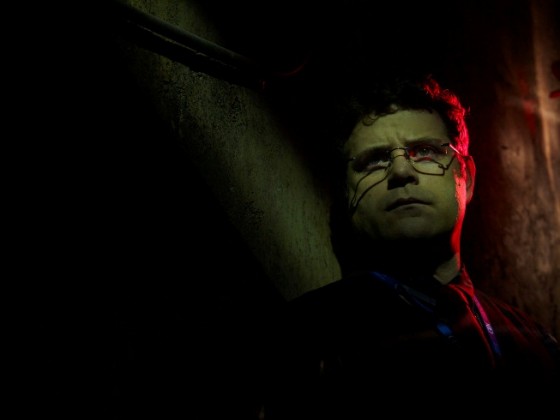
Q. Thanks so much for speaking with us. I’m a huge admirer of both you guys’ creative work, so this is totally exciting.
G. del Toro Thank you.
C. Cuse Thanks.
Q. What I wanted to ask, some would say you could have taken the series to HBO, Fox, even the big screen, so what about FX made you decide the network was the right place for The Strain?
G. del Toro We had a fantastic first meeting, if I may say so. We had an incredible meeting in which the very head of the network and everybody in that room knew patently well and intimately the three books. And yet they were excited by Carlton, they were excited by the possibility of not just doing the books but where would Carlton take it as a show runner, they were excited about, okay, that’s the universe, but we see many more possibilities than that. That made it very unique in our eyes. And they celebrated the aspects of the series that were edgier, or less of a kind that we have seen before.
And the other thing for me that was unique is I’m a follower of the brand, I’m a big FX fan, and they give you time to find your footing. They give you time to establish, especially in a genre like this, you know you cannot just do everything at once, reinvent everything at once. You either reinvent the characters in a genre story, or you reinvent the generic traits with characters that you’re able to place in the normal canon of the genre and then little by little evolve those characters, and that needs time. And FX has been known to be supportive of series that find their footing and creatively allow them to explore anything from characters you’ve seen before that then transform into things that are new, or concepts that are very new that go to daring places. So, it made it a unique place for the show.
C. Cuse And I would just add to everything that Guillermo said, that again we were presenting them with a very specific business model about how we wanted to approach the show, that we wanted to have the show last between three and five seasons, that we needed them to spend a bunch of money up front to do the R&D and the work that was necessary to do the world building for our show, and they would have to spend money up front on writing a bunch of scripts. And they jumped in wholeheartedly and they embraced the way in which we wanted to produce the show, as well as our creative vision, and we felt incredible confidence coming out of our meetings with them that they were the exact right partners for us.
Q. Hi, thank you so much for talking with us today. I just wanted to know, it seems like the show also focuses on personal crises and how the characters respond to that, just as much as it does the supernatural elements, they often have their own things going on in their lives. But I wanted to know more about how you plan to maintain the balance between the supernatural elements and the characters’ personal lives and how they’re handling what’s going on there as well throughout the season.
C. Cuse I think that the personal lives of the characters are very important. And I think that television is about forming a bond between the audience and the characters that exist in the world of the show, and I would say that on Lost we spent 80% of the time talking about the characters and maybe 20% of the time talking about the mythology, at the most. And I think that that’s why the show was more popular than being just a narrow niche genre show, and the audience was concerned about whether Kate was going to end up with Jack or Sawyer as much as they were about whether they were going to get eaten by the smoke monster.
In this show I think we’ve tried to take the same approach. We want the audience to engage in our characters, we want to understand who they are, what their lives are like, where they came from. I think as much as these vampires are causing upheaval in the city, they’re also causing upheaval in the personal lives of the characters, and we’re seeing these characters have to come to terms with the upending of the social, emotional, personal structures of their lives. And that stuff is a very important part of our storytelling.
And again, we spend a lot of time in the writers’ room talking about who these characters are, what they want, apart from just getting rid of the vampire plague, and I think as we go downstream with the show one of the things that excites me, and I know excites the other writers, is getting a chance to even get further into who these characters are and watch their relationships unfold with each other as they’re in the middle of this incredible crisis.
G. del Toro Well, I think that it’s very hard to define the dynamic of a show until you are five or six episodes into it. But I can say that we tried to balance very hard small moments, for example, the moment where Eichorst, the German vampire, meets with Setrakian through a pane of glass in the visitation booth, or the moment the father receives his lost daughter coming back home, with bigger action set pieces.
Now, that balance continues throughout the series. I think we are in some degree completed all the way through Episode 13, and we’ve seen that we have successfully maintained quiet character moments with bigger moments. How successful they are obviously is dependent on your empathy with those characters, but the fact is as a genre piece we need to have identifiable characters, the scientist, the sidekick, this and that. But we also go to characters that normally you don’t get in a series like this, a case in point, for example, Miguel Gomez as Gus, a character that seems to be on the fringe of the tale and gains his own footing, the very character of Setrakian, which is a character you’ve seen before but has a twist that you haven’t seen. It is my hope that in the evolution of the series Corey Stoll, which is the square-jawed, troubled hero that you may identify from other series, evolves into places that are much darker and challenging, both for the character and the actor.
But that balance occurs over time. And I can say with great pride and great hope that we have made it a point to maintain the balance through the series and hopefully take it even further as we go along.
Q. Hello, guys. Thank you so much for doing this today. My question is for Guillermo. Guillermo, I know that you were raised by your Catholic grandmother—
G. del Toro Yes.
Q. I was curious as to how much of the religion you grew up around has influenced your storytelling over your extensive body of work?
G. del Toro I think very much.
Q. I think so too.
G. del Toro I do. I know that as a Catholic the main mythology I seize upon, the way I understand the world, comes from that upbringing, including The Strain, which goes to very definite mythological and spiritual places in the third novel, it comes all from that. I really like to think about what it is that makes you right or wrong in this world and all that moral ambivalence is in the heroes.
As I said again and again in these interviews, one of my fascinations with the character of Corey is that he’s a character that is very certain but somewhat emotionally remote in the series. And in many ways Setrakian, who’s more outlandish, should be relatable in the way that Corey has too much certainty of himself, and little by little he goes to a place of spiritual doubt, and ultimately enlightenment, in my opinion, as a character. So that’s definitely inspired very specifically by Catholic lore.
And I’m thinking, one of my favorite books in the Bible, and one of the most mysterious books in the Bible that I relate to the most is the Book of Job, in which a man of faith is basically stripped of everything before finding a direct line to God’s voice. And I don’t want to sound like you’re about to step into a Catholic symposium dissertation with vampires, but ultimately that speaks very highly to the arc of Corey. So you need him to start the series on a place of full certainty, and end up in a place of spiritual discovery.
Q. Hi, guys. Thanks so much for talking with us today. It’s a pleasure to speak with both of you.
C. Cuse Thank you.
Q. My question is for Guillermo. I’m sorry I mispronounced your name.
G. del Toro No, you didn’t.
Q. Yes, sir. I’m wondering, what was it like for you personally to see this story that you’ve worked on and you had on the page come to life on the screen?
G. del Toro It was really beautiful to go through the process with new partnerships. I think that it’s great to do it with a partner that has been so close to the books, like Chuck, and someone that seems to have such a strong and revitalizing take as Carlton. I think it has really been quite energizing for me to see that. I think that Carlton and I both come from a world where partnerships are basically a single-minded approach to storytelling. Carlton and myself are used to storytelling on the audiovisual universe in an absolute way, and this partnership has required truly growth and opening into, wow, our views are enriched by both of us having really strong points of view, which is not unlike the partnership I have with Chuck Hogan to write a four-handed novel is just as strong and balanced as the balance that I think Carlton and I have at this stage.
And it has been, quite frankly, great to hear “No” from Carlton, to say, “No, now listen this is why we’re not going to do this.” And to learn from that, to say, wow, I never thought about it in that way. The idiosyncrasies of being a film maker and director, or a writer is that you domineer basically what happens, you want the character to go right and crash a car. And this is truly one of the most complete collaboration processes I’ve experienced with the triumvirate that is Chuck, Carlton, and myself. It’s hard to define where every territory ends, but it’s not hard at all to know that each of us brings a different strength to the project, and we trust each other. So, that process has been the most beautiful difference between putting the project on the page and seeing it fortify as a series, that you don’t exactly land where you thought you would land but you land on a place that feels incredibly right.
Q. Okay, thanks guys. My question is, these days so many people view TV as an online social event and are constantly reviewing and Tweeting about shows in real time as they happen. I’m wondering, will either of you be following along with conversations on Twitter or other social media, or how do you measure the audience reactions?
C. Cuse Look, I think that both Guillermo and I are very hopeful that fans are going to embrace the show, and we’ll be looking out there to see how people react. And I think it’s also instructive as we hopefully go forward with the second season of the show to see what people like and don’t like. I think the advent of social media has created a real dialogue around television shows, and I think that certainly there was a lot of beneficial aspects of that that I experienced when I was doing Lost, and I expect the same from The Strain.
I’m personally enormously curious to see how people react to all sorts of things. And it’s fun, too, because when you create something on film and you put it out there you have a certain expectation, and sometimes you get exactly what you expect back in terms of reaction, sometimes you get surprising reactions. And we’ve been working on this project for almost two years, and so the idea that we’re now going to see what people think of it and get their honest, true, and complete feedback is very exciting to me.
G. del Toro I think that when we started the journey on the screen early in the novels we started in 2006, and you really don’t get an immediate reaction that is a dialogue that fast with the books or the comic adaptation. I think that the fact that we can see the audience reacting to it in an immediate way is going to be in the mid-to-long term incredibly useful. I’m a social media shut-in, I don’t use Twitter, I don’t have a Facebook page, I don’t have any of those things, so I’m socially inept in that way. But I certainly am aware of the Internet reaction. I don’t respond because I don’t have the mediums to respond at hand, but I do read the feedback and I do think you have to be able to feed on it and react to it in the proper way. Obviously, on a chapter to chapter engaging, it can be as disorienting as a super fast tennis match, like it, not like it, like it, not like it. But ultimately as the first season plays out and people find that they are listening to the real voice of the series, we can find things that we did right and connected, and we can find out things we did wrong and learn from it.
The main beauty of television for me, and what Carlton has been repeating to me almost as a mantra, is a version of “take it slow,” a version of, I come from a world that within the first three days of a movie hitting an audience you have defined its immediate interaction, the box office results, the gauging, and the release of the movie’s done. With Carlton it’s been, look, we can always learn and correct direction, we can always add on, we can fortify. None of the traits of a show are set in stone. All of them are malleable to define the property itself. And that’s really captivating and unique to television. So, I do expect great feedback either way from an audience that will help us create a show that delivers the experience and the uniqueness of the narrative of The Strain books in a new medium. So I’m very much looking forward to it.
C. Cuse Yes, what Guillermo said is exactly right. Television is a very organic medium, and you have the opportunities, you have a long term ongoing relationship with your audience. And I think we’re just now entering that phase with the show, but hopefully this dialogue is going to continue for a long time to come.
G. del Toro Yes, I always say jokingly about myself that I do not like the idea of film making as a brand. I like the idea of film makers becoming an acquired taste for an audience. I think that I myself think I am an acquired taste, and I love being that because I’ve enjoyed, over two decades, a very close relationship with the audience that likes what I do. And I always pay close attention to their reaction, to feed from it and to go into new ventures.
***
Once again, many, many thanks to Carlton Cuse and Guillermo del Toro for their generosity of time and insights into the creation and future of their phenomenal new series.
The Strain, starring Corey Stoll, Mia Maestro, Sean Astin, David Bradley, Kevin Durand, Natalie Brown, Jonathan Hyde, Richard Sammel, Robert Maillet, Jack Kesy, Ben Hyland, and Miguel Gomez, premieres Sunday, July 13 at 10/9c on FX.


